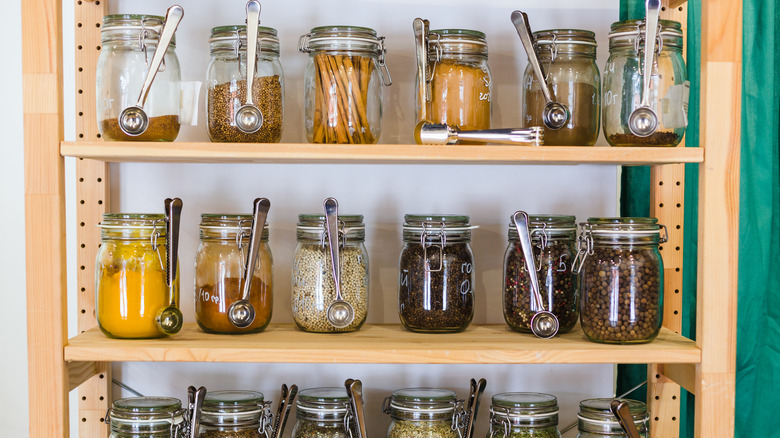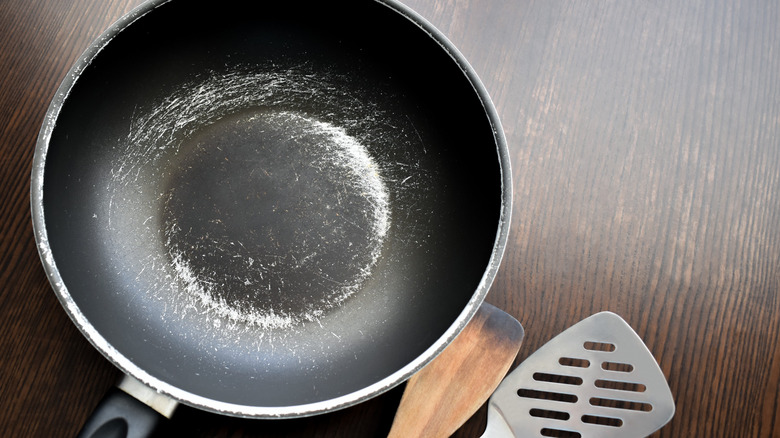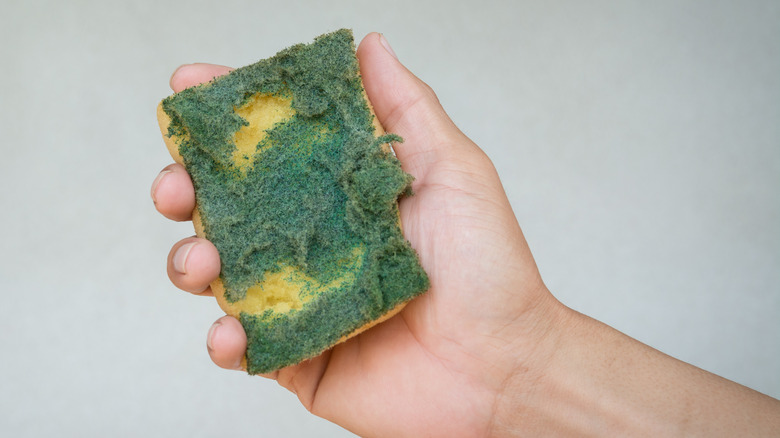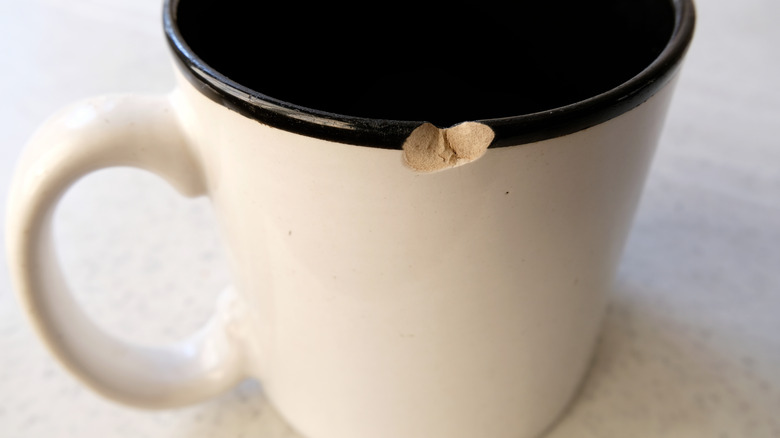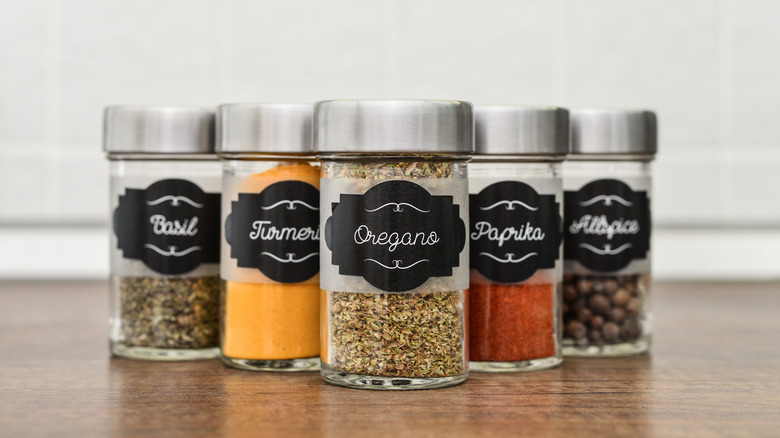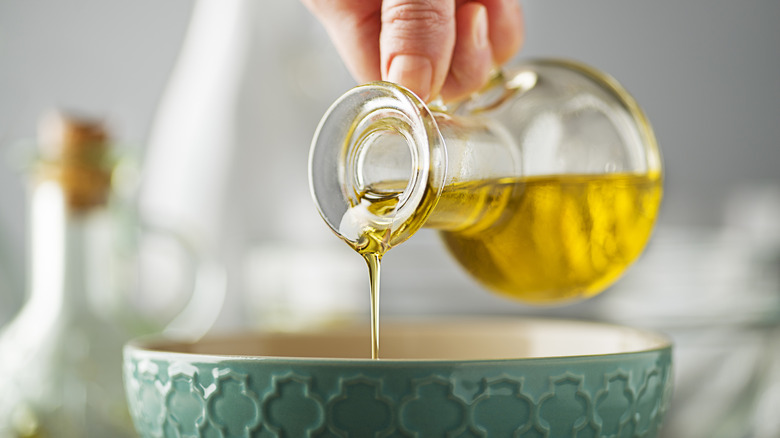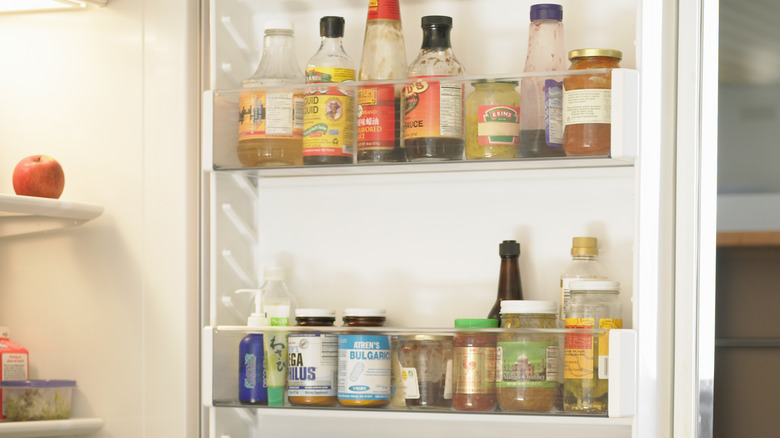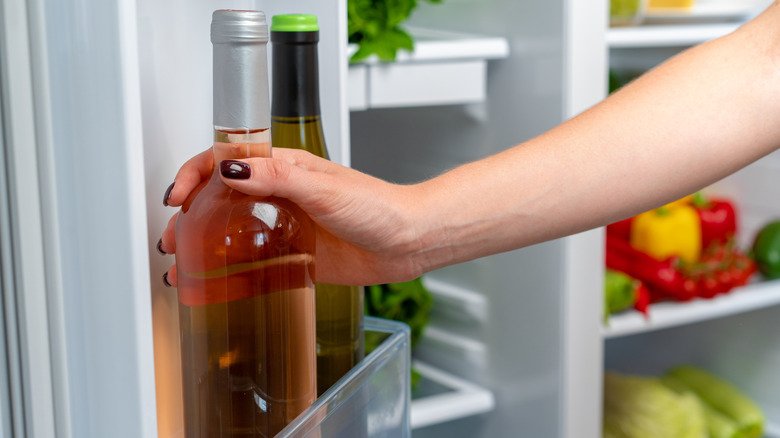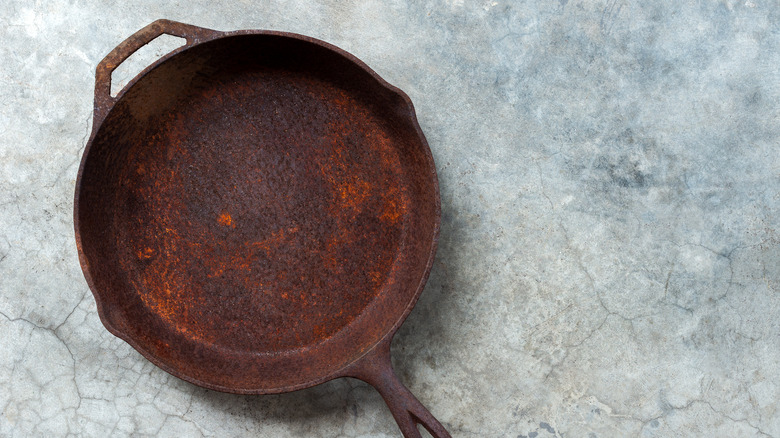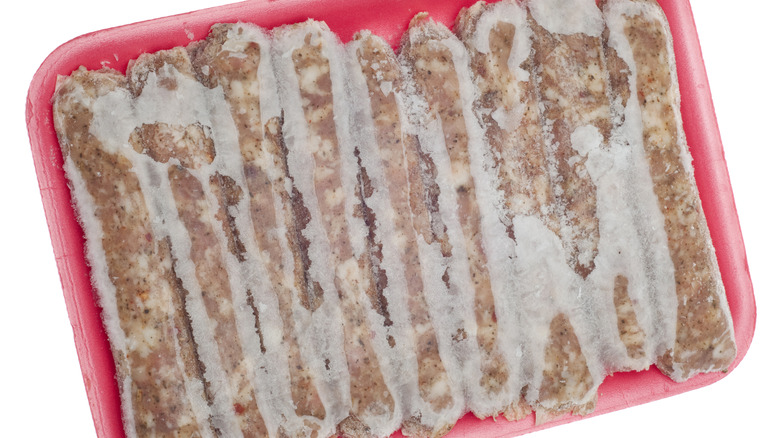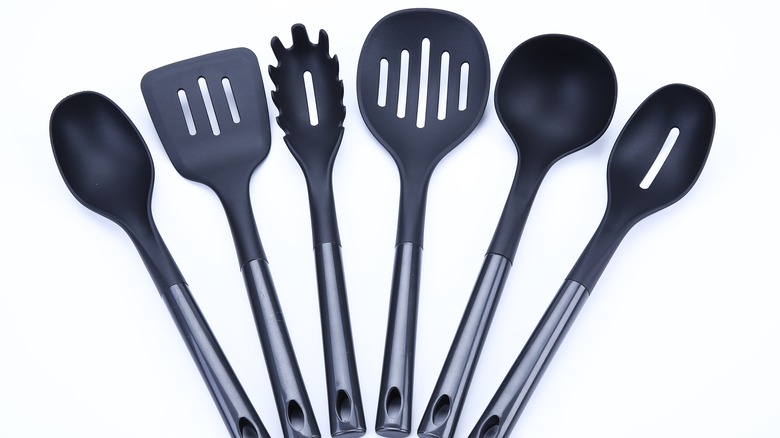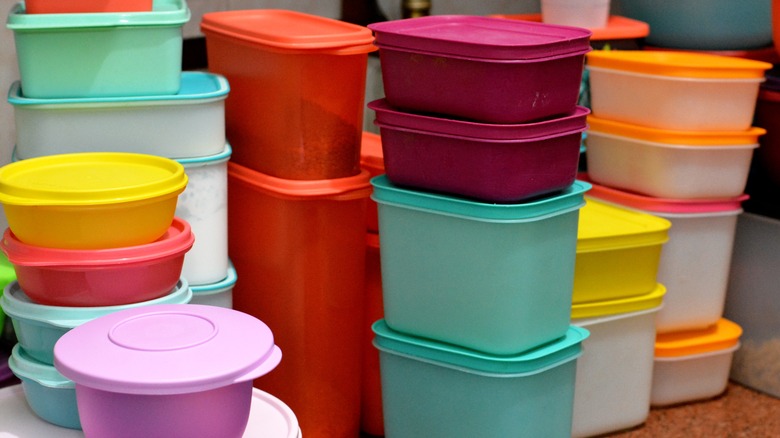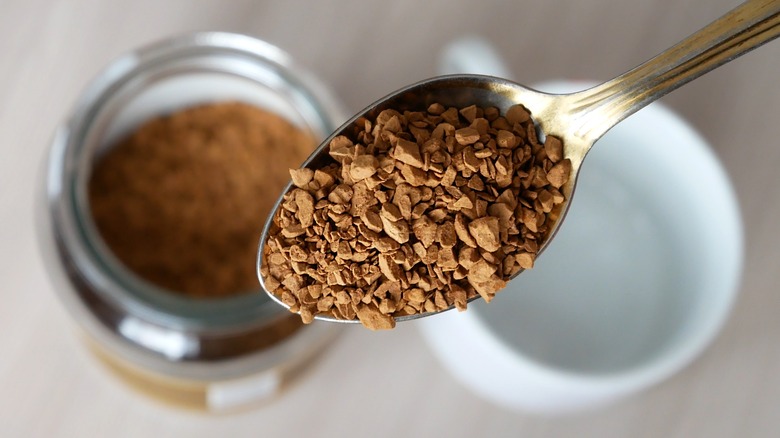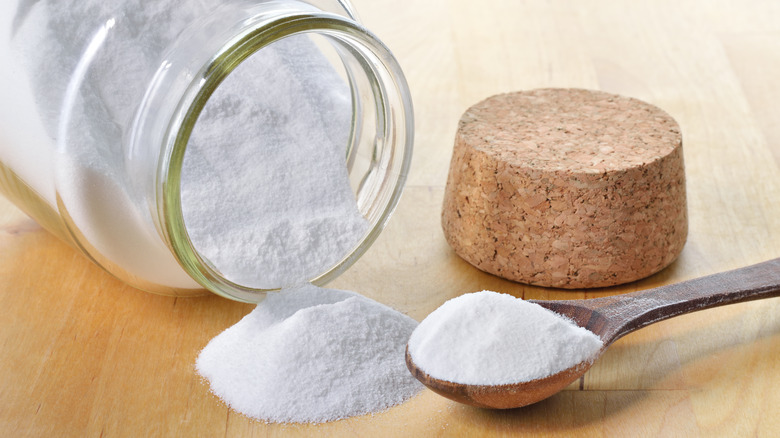13 Things In Your Kitchen You Should Never Reuse
The heart of the home, the kitchen is a space for our cooking creations, baking fun, and family gatherings. Despite it being such a well-used room, it can be easy to forget the importance of having a good kitchen clear-out every now and again. While the mantra of reduce, reuse, recycle is of course vital for many items in our homes, there are certain things lurking in our kitchens that certainly should not be subjected to a second life. From compromised flavors to potential health hazards, reusing certain kitchen essentials can pose risks that far outweigh any benefits.
If you're on a mission to reclaim the sanctity of your kitchen, you're in the right place. We've rounded up some top recommendations for items that, quite frankly, are best to toss. Before you reach for that scratched-up frying pan or ancient jar of spice, take a moment to consider the consequences and explore safer, fresher alternatives. So, join us as we scour through the depths of our kitchen cupboards and counters to shed light on 13 items that it's probably time to say goodbye to.
1. Scratched non-stick cookware
Some of the most used items in our kitchens, non-stick pots and pans are perhaps something we don't consider throwing away at the sight of a scratch or two. After all, a quality pan can be expensive, so we want to get as much use out of it as possible. However, those scratches can, in fact, pose a potential threat to both the quality of our meals and our health.
When non-stick cookware becomes scratched, it creates tiny crevices where bacteria can thrive, increasing the risk of foodborne illnesses. Moreover, these scratches can compromise the integrity of non-stick coatings, leading to burnt food and the release of harmful chemicals. In particularly bad cases, flecks of the non-stick coating might come loose as you're cooking and get mixed in with your food. That's not something we want to be eating.
While it may be tempting to cling to a well-worn pan, it's best to know when you should replace your non-stick pan with a new, unblemished version. Stainless steel and cast iron cookware are excellent alternatives, being both durable and scratch-resistant. To preserve the surface of your pans, it's best to avoid metal cooking utensils, which can lead to scratching. Instead, opt for silicone or wood, which are just as effective but more gentle on the pan.
2. A well-used dish sponge
Though we use it day in and day out for all of our washing-up needs, a dirty kitchen sponge can easily go unnoticed. But this kitchen essential is perhaps one of the most important things to keep on top of replacing.
Over time, sponges become breeding grounds for bacteria, with studies revealing that they can harbor more germs than a toilet. The moist environment of a sponge provides the perfect environment for bacteria like E. coli and Salmonella, posing a significant risk of cross-contamination during dishwashing. While it may be tempting to prolong the life of our trusty sponges, their potential health hazards surely outweigh any cost-saving benefits.
Regularly sanitizing sponges can help mitigate the risks of bacterial growth. You can do this by placing the sponge in a bucket of diluted bleach or by boiling the sponge in a pot of water for five minutes. However, while these methods can reduce the amount of bacteria, they don't always remove it completely. So, your best bet is to replace your sponge once a week to ensure optimal hygiene in the kitchen. Alternatively, consider switching to reusable dishcloths or scrubbers, which are easier to sanitize and less prone to bacterial growth.
3. Chipped crockery
You might think that a small crack or chip in your favorite bowl, plate, or mug is nothing to worry about. But, keeping hold of damaged crockery is not a good idea, and using it can mean potential threats to your safety.
Chipped crockery creates jagged edges where bacteria can lurk, increasing the risk of contamination during meal preparation and serving. These chipped edges can also be sharp, which presents the risk of cutting or scraping your hands or mouth. Furthermore, even if seemingly small, cracks can compromise the structural integrity of the dish, which could lead to breakage and injury.
So, it's always safer to replace damaged dishes with new ones to ensure safety in your kitchen. If you're too attached to your favorite bowl or plate to toss it, try repurposing chipped crockery for non-food-related purposes such as decorative accents or plant pots, giving them a new lease of life while removing any risks that come with using them for meal prep.
4. Old herbs and spices
A staple for infusing home cooking with flavor, most of us have an array of herbs and spices in our kitchen cabinets. But just how long have they been sitting there?
Many of us can probably admit that some of those spice jars were bought quite a long time ago and have since only been reached for a handful of times. When they've overstayed their welcome, these once vibrant and flavor-packed ingredients can become a little lackluster. Herbs and spices that are past their best will lose both taste and potency. If moisture has found its way into the jars, you might also notice that powdered spices have become hard or clumpy. As time ticks on, these neglected jars can become breeding grounds for bacteria and mold, and using them could be harmful to our health.
To keep your cooking flavorsome and safe, have a good clear-out of any old herbs and spices. Take some time to sift through your collection, discarding any jars that have passed their expiration dates or are showing signs of deterioration. You can also open them up and give them a sniff. If they don't have a particularly strong smell, they probably no longer have much flavor, either. Once you've tossed any old jars, simply refresh your spice rack with new replacements, storing them in a cool, dry spot to keep them fresh for as long as possible.
5. Old olive oil
Another frequently reached-for item in our kitchens, olive oil gives food rich flavor while offering plenty of health benefits. However, like any cooking ingredient, it has a shelf life.
When we store olive oil past its expiry date, this can result in a decline in both flavor and quality. Over time, exposure to air, light, and heat can cause olive oil to oxidize, leading to a rancid taste. Consuming rancid olive oil not only affects the taste of your dishes, but can also have negative effects on your health.
To ensure that your olive oil retains its freshness and flavor, keep an eye on the expiration date and get rid of any bottles that have lingered past their prime. Most olive oils should last around 18 months from the date of bottling. It's always good to pay attention to the color and aroma of your olive oil too. If it smells musty or has a rancid odor, it's best to toss it.
If you're not a frequent user of olive oil, it might be best to opt for a smaller bottle when replenishing your supply. That way, you'll find it easier to use up within a reasonable timeframe to minimize the risk of spoilage. Store your olive oil in a cool, dark place away from heat sources and sunlight to prolong its shelf life and preserve its flavor.
6. Expired condiment bottles and jars
Hands up if you're a condiment collector! With so many options to choose from, many of us dedicate a good portion of our fridges and cupboards to these trusty sauces and flavor enhancers. And these are some of the most overlooked items in our kitchens when it comes to expiration dates. When stored for too long, expired condiments can become more than just flavorless — they can also harbor hidden dangers.
As condiments near their expiration dates, their flavors begin to fade, meaning they won't pack as much of a punch when it comes to enhancing our dishes. Moreover, the ingredients in these bottles and jars can degrade over time, potentially leading to changes in texture, color, and even the development of harmful bacteria. Consuming expired condiments can therefore pose risks to your health.
Many sauces and relishes will have guidance on the packaging as to how long they can be used after opening, and it's often not as long as you'd think. For example, the USDA recommends keeping opened mayonnaise in the fridge for no longer than two months.
To remove the worry of getting sick, throw away those old condiment bottles and jars that have been sitting in your kitchen for far too long. After you've had a clear-out, you can update your collection with fresh replacements. Once opened, store your condiments in the fridge rather than the cupboard, as this can help to prolong their shelf life.
7. Old bottles of opened wine
We might use a splash of wine in our cooking or enjoy a glass with dinner before popping it back in the fridge. Yet, opened bottles of wine sometimes get forgotten, left sitting unused in the fridge or cupboard. Sadly, wine can go past its prime fairly quickly, rendering it disappointingly undrinkable.
As time passes, opened bottles of wine undergo chemical changes that can alter their taste, aroma, and overall quality. Exposure to air accelerates oxidation, leading to a loss of those pleasant fruity flavors and increasing the acidity. This can give the wine a vinegar-like taste. Additionally, bacterial growth can occur, resulting in the development of off-flavors, unpleasant odors, and potentially even food poisoning.
Wine should last for up to five days once opened. It's always best to keep it in the fridge, with the cork put back in or the screw top firmly secured to prevent oxygen and bacteria from getting into the bottle. So, take a look at your wine collection and make sure to dispose of any bottles that have been hanging around for a little too long.
8. Rusty pans
Scratched pans might be a no-go, but what if they're rusty? Neglected cookware often succumbs to unsightly rust, which tarnishes both its appearance and functionality.
Rust forms when moisture and oxygen interact with the metal surface of pans, leading to the formation of iron oxide — a reddish-brown substance that can flake off and contaminate your food. Cooking with rusty pans can result in metallic off-flavors and dish discoloration. Furthermore, the USDA advises that rust is not safe for consumption. While small amounts of rust are unlikely to cause serious health issues, it's not worth taking the risk.
Inspect your cookware regularly for signs of rust. If there are only a few small patches, you might be able to remove the rust with a metal scrubber, running the pan under cold water as you go. Make sure to dry the pan quickly by heating it on the stovetop to prevent more rust from forming. If the rust isn't budging, even with some elbow grease, it's best to retire the pan and invest in a replacement.
When caring for your cookware pieces, avoid soaking them for extended periods to prevent rust formation. Additionally, consider re-seasoning your cast iron pans with oil regularly to create a protective layer that inhibits rust and enhances non-stick properties.
9. Freezer-burnt food
Freezer burnt food is a dreaded sight amongst batch cookers and meal preppers. If frozen improperly, you might notice those tell-tale ice crystals or dry patches on once-perfect portions of food. While it's not harmful to eat, freezer burn can completely ruin the taste and texture of your favorite frozen treats.
Freezer burn occurs when frozen foods lose water through a process called sublimation, leaving them dehydrated, lacking in flavor, and sometimes shriveled in appearance. If you don't want to experience the disappointment of a tough, flavorless meal, dispose of any freezer-burnt food in your freezer rather than trying to revive it.
To prevent freezer burn, take a moment to wrap items securely in freezer-safe packaging before freezing. This will minimize exposure to air and moisture. Ensuring your freezer is at a temperature of 0 degrees Fahrenheit or lower will also reduce the risk of freezer burn. Another top tip is to label containers with the date of freezing to keep track of storage times and prioritize using older items first to prevent waste. That way, you can ensure that the contents of your freezer retain optimum freshness and flavor.
10. Plastic cooking utensils
Plastic cooking utensils are often praised for their affordability and versatility in the kitchen. However, these seemingly reliable tools can actually pose hidden risks to our health and well-being.
When plastic cooking utensils are exposed to temperatures above 158 degrees Fahrenheit, they release toxic byproducts called oligomers, which can easily transfer into your food. Consumption of such oligomers has been linked to liver and thyroid issues, as well as increased risks of cancer. If your spoon or spatula is scratched up, it makes it even easier for pieces of plastic to fall off, increasing the toxic load in your food. Therefore, it just doesn't seem worth taking the risk when there are so many other options available for your cooking needs.
Consider investing in utensils made from alternative materials like wood or silicone. These alternative materials offer greater durability and, more importantly, fewer risks to your health.
11. Plastic containers
The infamous plastic container storage cupboard is a feature in many kitchens, overflowing with countless containers and mismatched lids in all different shapes and sizes. But, like cooking with plastic utensils, storing our food in these containers can be harmful to our health.
Bisphenol A (or BPA) is a chemical that has been used to make plastics since the 1950s, including the food containers in your kitchen. However, in the last decade or so, an array of potential health problems caused by BPA have come to light, with its exposure being linked to neurological issues, certain types of cancer, and reproductive abnormalities, amongst other issues.
Since around 2012, manufacturers have been producing BPA-free plastic products. But if you can't remember how long you've had a particular container, there are a few ways to check whether it's likely to contain BPA. Polycarbonate plastics display the recycling code 7, so anything with this number may have been made with BPA. (Note that other plastics also get this code, so it's not a foolproof sign it's made with BPA). Anything labeled as microwave-safe or non-breakable is also likely to contain the harmful chemical.
Furthermore, just because a plastic container is BPA-free, it can still contain other potential toxins. There are a variety of chemicals used in plastic production that can leach from containers into our foods, and we are yet to know how these could affect our health. To remove the worry, try switching to some of the best glass containers.
12. Stale coffee
Enjoyed daily by many of us, coffee is a kitchen cupboard staple, but did you know that it can go stale? When left exposed to air and moisture, coffee beans or grounds can lose their freshness and vibrant flavor, resulting in a brew that fails to deliver the satisfying coffee experience we crave.
Though it won't spoil or become unsafe to consume, stale coffee is likely to disappoint the palate with its flat, muted flavors. To experience the flavor profile in its full intensity, drink your coffee by its "best before" date. Whole coffee beans will typically stay fresh for longer than ground coffee, with an opened bag keeping well for up to three weeks. On the other hand, coffee grounds are best used within two weeks. Therefore, it can be beneficial to buy coffee in bean form and grind it yourself to keep your drinks tasting fresh and delicious. Storing coffee in an airtight storage jar or container is another great way to ensure it lasts for as long as possible.
Make sure to check the dates on your coffee and get rid of any bags that are likely to result in a lackluster brew. Buying your favorite coffee in smaller quantities that you'll use up within a couple of weeks is always best.
13. Expired baking powder and baking soda
Baking powder and baking soda are common additions to our cakes, breads, and cookies. With recipes usually only requiring a small amount of these leavening agents, it can take some time to get through a whole tub.
These trusty leavening agents rely on chemical reactions that produce gas bubbles, which lift and aerate batters and doughs. Over time, exposure to air and moisture can cause these powders to lose their effectiveness. When baking powder and soda reach the end of their shelf life, they fail to deliver the rise and texture we expect from our baked creations. This can lead to flat, dense baked goods that lack the fluffiness or tender texture we were going for.
So, give the expiry date on your baking powder and soda a check. If they're past it, make sure to replace them with a fresh tub. If they're close to the dates are you're unsure, there's a handy way to test whether they're still effective. Simply add a little baking powder to some hot water. If it fizzes and bubbles, it's fit for purpose! You can use the same technique to test baking soda, but you'll need to add a little vinegar to the water, too.
